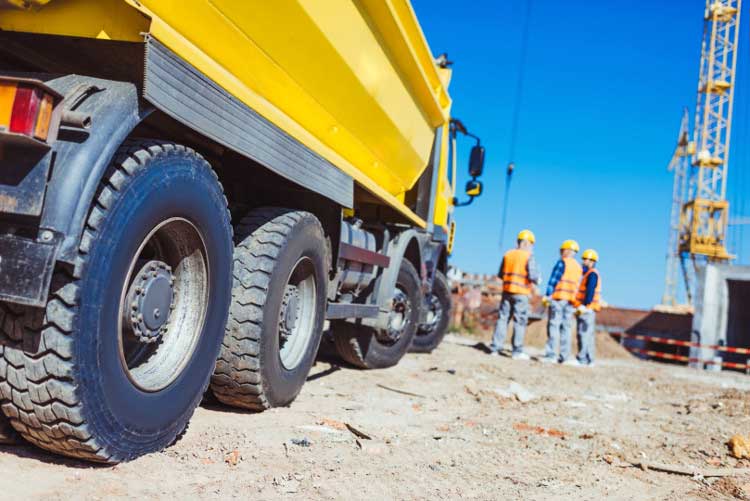- Home
- Loss Control
- Loss Control Insights
- Strategies for Preventing Backover Accidents
When you’re setting up a work zone, you probably spend a good amount of effort protecting your people and property from nearby vehicle traffic. Careless or confused drivers pose a danger to your roadside employees, but did you know that workers are actually more likely to be hit and killed by a construction vehicle that’s working inside the work zone?
The hazard you never saw coming
A backover incident happens when a worker is struck by a backing vehicle. Backovers can be caused by a variety of factors, including employees who are distracted or working in the vehicle’s blind spot, drivers who assume the path is clear, and faulty or inaudible backup alarms. Workers may also fall from a vehicle which then backs over them as it continues to move. Despite the wide range of causes, backovers are preventable with adequate planning, communication and technology.
| Vehicles Causing the Most Backover Fatalities 2005-2010* | |
| Dump Truck | 67 |
| Semi/Tractor Trailer | 40 |
| Truck | 30 |
| Forklift | 21 |
| Garbage Truck | 20 |
| Pick-Up Truck | 16 |
*OSHA Integrated Management System data
Minimize backing with an internal traffic control plan
An internal traffic control plan is an effective way to minimize interaction between construction vehicles and workers on foot by creating routes and operating procedures for large trucks delivering materials. Routes are designed to minimize backing and ensure all parties operating within the activity area know the locations of people and equipment. By restricting vehicles to certain areas and making their actions more predictable, you make it easier for employees to avoid the hazard entirely.
- Guidance: Developing Internal Traffic Control Plans for Work Zones
- Fact Sheet: Internal Traffic Control Plans for Work Zones
Communicate with employees about changes to hazards
Daily huddles are a quick and easy way for supervisors to inform workers of what’s going on that day. Besides promoting safety and hazard awareness, they can help make your crew more productive and organized. Hold huddles in the morning and keep them short. Want to go for extra credit? Hold an afternoon huddle as well to review the day’s progress and plan for tomorrow.
- Using Daily Huddles to Keep Your Crews Focused and Productive
Use spotters to help drivers avoid people and hazards
Do drivers on your jobs use spotters every time they back a vehicle? If not, maybe they should. According to OSHA, spotters are a proven method for protecting employees on foot behind vehicles with obstructed views. But spotters need to be on guard to avoid being backed over themselves.
Drivers and spotters should agree on hand signals beforehand, and drivers should stop backing immediately if they lose sight of the spotter. Spotters should wear appropriate high-visibility clothing and be free of distractions, such as other duties assigned simultaneously, cell phones, etc.
- OSHA: Spotter Safety
- Spotters: A Critical Element of Site Safety
Teach operators to recognize their blind spots
Different types of construction vehicles have different blind spots, which affect how they can be backed safely. Whether they are driving a dozer or a dump truck, operators should be familiar with the unique limitations of the equipment they are using. Provide training using equipment diagrams that display blind spots, or better yet, conduct hands-on blind spot training with this exercise. For pickup trucks and passenger vehicles, try this technique for adjusting mirrors to minimize blind spots.
- NIOSH: Construction Equipment Visibility Diagrams
- Know the Blind Spots Poster
Help workers dress for success
Anyone working around big trucks and construction equipment should be wearing high-visibility safety apparel. At a minimum you should be outfitting workers in Class 2 vests, however Class 3 apparel offers significantly greater visibility, which can help prevent backovers.
- Increasing the Work Zone Worker’s Visibility Through High-Visibility Safety Apparel
Consider new technology for preventing backovers
A variety of new technologies are available to help prevent backover incidents. Backup cameras are familiar to us in passenger vehicles, and they are also available as optional equipment on some construction vehicles. Aftermarket cameras are also available for retrofitting older pieces of equipment.
Proximity detection systems and tag-based systems use radar, ultrasonic systems and electromagnetic fields to alert drivers when an object or person is in the path of the vehicle or mobile equipment.
Get in touch
Need help? We’re here for you! Whether you have questions or need personalized assistance, your local office is ready to support you.
Loss Control Insights
Stay informed with the latest news and receive actionable safety tips, all carefully curated by our team of experts.
